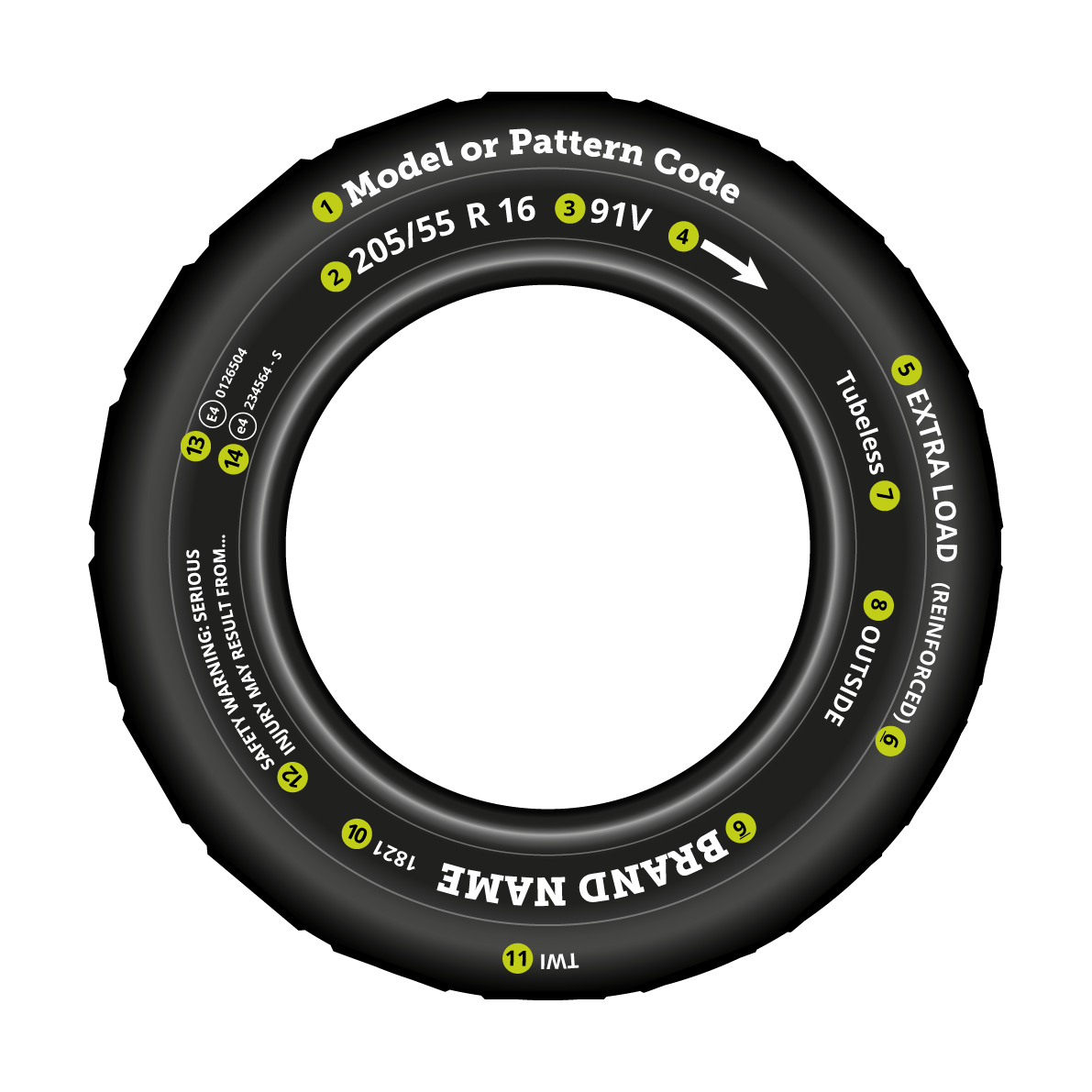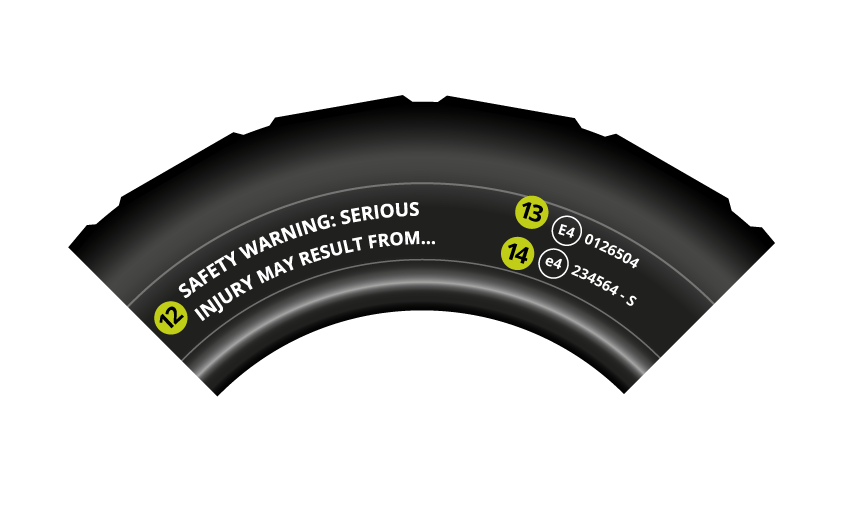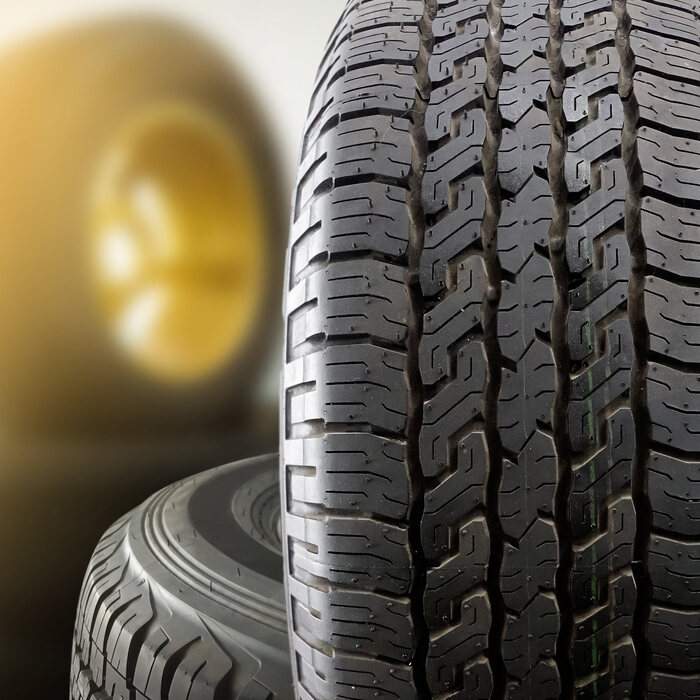CAR TYRE MARKINGS EXPLAINED
Car tyre markings are a series of codes, numbers and letters along the tyre sidewall that offer information such as size, safety specifications, and manufacturing information.
It’s important to know what these sidewall markings mean, to ensure you’re not only using the correct tyres for your vehicle, but also not exceeding the maximum weight and maximum speed, which in turn means better fuel efficiency and - of course - safety.
1 Model or pattern code
This code refers to the model number specified by the manufacturer. Each tyre will have a different model number based on the other specifications.
2 Tyre size
This code is usually represented by seven numbers and a letter, divided by a slash.
The first three numbers represent the width of the tyre in millimetres. This is measured from sidewall to sidewall.
Numbers four and five (following the slash) represent the aspect ratio. The number acts as a percentage of the tyre’s width.
The letter represents the construction. For example, R, D and B, which stands for radial construction, diagonal construction and bias belt construction.
The final numbers represent the wheel diameter. To mix things up, this measurement is actually in inches, and is the size of the rim the tyre is designed to fit.
3 Service description
The service description explains the load index and speed rating of the tyres, and is represented by two/three numbers and one/two letters. These codes are universal and are used by all manufacturers.
The load index is two or three numbers that represent the maximum weight in kilograms the tyres can carry.
|
Load Index |
Kilos |
Load Index |
Kilos |
Load Index |
Kilos |
|
65 |
290 |
80 |
450 |
95 |
690 |
|
66 |
300 |
81 |
462 |
96 |
710 |
|
67 |
307 |
82 |
475 |
97 |
730 |
|
68 |
315 |
83 |
487 |
98 |
750 |
|
69 |
325 |
84 |
500 |
99 |
775 |
|
70 |
335 |
85 |
515 |
100 |
800 |
|
71 |
345 |
86 |
530 |
101 |
825 |
|
72 |
355 |
87 |
545 |
102 |
850 |
|
73 |
365 |
88 |
560 |
103 |
875 |
|
74 |
375 |
89 |
580 |
104 |
900 |
|
75 |
387 |
90 |
600 |
105 |
925 |
|
76 |
400 |
91 |
615 |
106 |
950 |
|
77 |
412 |
92 |
630 |
107 |
975 |
|
78 |
425 |
93 |
650 |
108 |
1000 |
|
79 |
437 |
94 |
670 |
The speed rating tells you the maximum speed the vehicle should travel while using those tyres. Exceeding this speed can generate heat the tyre isn’t designed to handle, and can cause a blowout. These speeds will generally be in excess of the maximum speed you can travel on British roads, which by law should be adhered to.
|
Rating Symbol |
Speed mph |
Speed km/h |
Rating Symbol |
Speed (mph) |
Speed km/h |
|
B |
31 |
50 |
P |
93 |
150 |
|
C |
37 |
60 |
Q |
99 |
160 |
|
D |
40 |
65 |
R |
106 |
170 |
|
E |
43 |
70 |
S |
112 |
180 |
|
F |
50 |
80 |
T |
118 |
190 |
|
G |
56 |
90 |
U |
124 |
200 |
|
J |
62 |
100 |
H |
130 |
210 |
|
K |
68 |
110 |
V |
149 |
240 |
|
L |
75 |
120 |
W |
168 |
270 |
|
M |
81 |
130 |
Y |
186 |
300 |
|
N |
87 |
140 |
ZR |
150+ |
240+ |
For more information check out our guide to tyre speed ratings.
4 Direction of rotation
This marking is only found on directional tyres. Directional tyres are designed to to travel in one specific direction, and fitting tyres like this should be done so carefully to ensure they’re on the correct side of the axle. When fitted, the arrow on the sidewall should face the direction of travel.
5 Extra load
Extra load, or XL, shows that the tyres are designed to carry heavier loads than standard tyres of the same size.
6 Reinforced
Instead of Extra loads, or XL, some tyres will have ‘Reinforced’ as an alternative.
7 Denotes tubeless Construction
If the tyre is tubeless, which applies to a majority of passenger vehicles, it will be marked with ‘tubeless’ on the sidewall.
8 Outer sidewall
This is only found on asymmetric tyres, because these tyres - as the name suggests - have sides that are a different shape, and thus aren’t symmetrical. When fitting these tyres, the ‘OUTSIDE’ should be facing away from the vehicle.
9 Manufacturer's name or brand name
This is the most obvious marking, which will be represented by the brand's logo. Mixing different manufacturers on the same vehicle is fine, so long as all the other specifications are the same. However, two different tyre types (e.g. directional mixed with standard) should not be used together.
10 Date of manufacture
Four digits which represent the date of manufacture. The first two digits relate to the week, and the last two relate to the year.
11 TWI
Tread wear indicators (TWI) are raised areas at the base of the tread grooves to serve as a visual warning for when the tyre is approaching - or at the - minimum legal limit.
12 Safety warning
This warning details anything the driver should be aware of to ensure optimum safety.
13 ECE R30 conformity approval number
The ECE marking shows that the tyres meet European safety and environmental standards. The letter E will follow a number, which represents a country, with the UK being E11.
14 EEC noise approval number
This number shows that the tyre does not exceed the maximum noise permitted by tyres of this size. Most tyres are around 4 decibels quieter than the maximum levels, which range from 72-76dB.
Buy tyres online
Car tyre markings are there to make understanding your tyres easier. If your tread wear indicators are showing that your tyres are beneath the legal limit, you can use our simple tool to enter your vehicle reg and buy tyres online today. We have tyres from all major brands to fit almost every make and model, and to fit every budget.






 Same Day Fitting. Order By 10:30am
Same Day Fitting. Order By 10:30am
 39 Nationwide Fitting Centres
39 Nationwide Fitting Centres
 5 Year Warranty On All Tyres
5 Year Warranty On All Tyres
 Price Check Promise. Always Great Deals
Price Check Promise. Always Great Deals

 Find a Centre
Find a Centre

